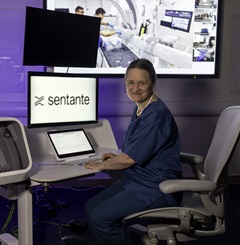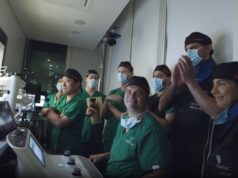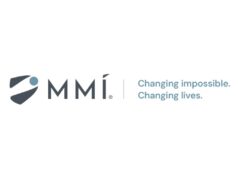
Sentante announced in a recent press release that it has successfully achieved a “first-of-a-kind” remote stroke procedure—performed by specialist surgeons guiding the interventions from different hospitals in Jacksonville, USA and Dundee, UK. Full end-to-end thrombectomies were performed on perfused non-living subjects with procedure-authentic pathology in the Image Guided Therapy Research Facility (IGTRF) at the University of Dundee (Dundee, UK).
Two distinguished operators performed these remote stroke interventions: endovascular neurosurgeon Ricardo Hanel (Baptist Medical Center, Jacksonville, USA) led the transatlantic procedure from his centre in Florida, operating on a unique, perfused human cadaver model located in Dundee. Interventional neuroradiologist Iris Grunwald (University of Dundee, Dundee, UK) also performed a remote stroke thrombectomy in the same location from a hospital in Scotland.
“This is undoubtedly one of the most exciting innovations in stroke intervention in the last decade,” Grunwald commented. “What amazed me most was how tactile the experience was. My hands felt exactly as they usually would if I had been doing a conventional thrombectomy. Sentante is at the forefront of innovation, and has created a viable solution to a major global healthcare problem. For most patients transported to a thrombectomy centre, treatment comes too late. Remote robotics has the power to decouple expertise from geography. Our demonstration shows that a specialist can perform a technically demanding neurovascular intervention from thousands of miles away, perhaps even from their home. It was an honour to perform the first remote thrombectomy in a human body and to then be part of the team that delivered the first transatlantic thrombectomy.”
“Tele-neurointervention will allow us to decrease the gap and further our reach to provide one of the most impactful procedures in humankind—the thrombectomy—to more people,” Hanel added. “To operate from the USA to Scotland with a 120-millisecond lag is truly remarkable.”
Sentante’s release notes that this success proves the potential of its technology to save the lives and ameliorate prognoses of patients suffering stroke episodes in remote settings; improve critical care and outcomes for stroke patients using robotic accuracy and precision; and create a fully digital process with rich data learning to inform the next generation of specialists and endovascular robotics.
“For an ischaemic stroke, the difference between walking out of hospital and a lifetime of disability can be just two to three hours,” said Edvardas Satkauskas, co-founder and chief executive officer (CEO) of Sentante. “Today, patients are often transported long distances to reach one of a limited number of thrombectomy centres. With Sentante, the specialist comes to the patient over a secure network, and performs the entire procedure remotely—with the same tactile feel and control they have at the bedside.”
Sentante is a haptic endovascular robotic platform using standard cath lab equipment—guidewires and catheters—connected to a device equipped with a high-resolution sensory system that captures the specialist’s hand movements. These manipulations are replicated in real time by a robot at the patient’s bedside, regardless of the distance between them and the operator. Unlike with joystick-controlled surgical robots, Sentante says it delivers authentic force feedback directly to the surgeon’s fingertips, recreating the tactile experience of manual surgery.
Sentante says its teleoperated robotic system also allows surgeons to perform interventions while seated at high-resolution screens displaying X-ray imagery, freeing them from radiation exposure and the physical strain of standing for prolonged periods. This “seamless” cath lab integration is beneficial to both physicians and patients, the company claims.
The recently announced procedure also evaluated network performance and latency across the transatlantic link, with Sentante partnering with Mischa Dohler—vice president of Emerging Technologies at Ericsson—in establishing multi-path connectivity to maintain a stable, secure connection for mission-critical use. Additionally, as part of the Nvidia Inception Programme, Sentante says it has utilised state-of-the-art technologies purpose-built for developing healthcare robots, supporting low-latency robotic applications and future developments of autonomous robotic systems and physical artificial intelligence (AI).
“Sentante is a tool that changes the work environment for cath lab and patients dramatically,” Satkauskas added. “This is about access and consistency. Access, because patients in remote or non-specialist hospitals can receive the gold-standard treatment without delay. Consistency, because robotics bring precision, stability and rich digital data that can support training and, over time, increasing levels of assistance. Remote stroke treatment is one of the strongest real-world cases in medical robotics. You need precision, stability, safety and teleoperation all at once. Our platform was built from day one to deliver exactly that.”
According to Sentante’s release, this demonstration follows prior remote work by the team at continental distances, with the company having also completed a clinical trial in peripheral vascular interventions using the same core platform operated from a control room adjacent to the theatre.
The Sentante system is currently advancing through regulatory pathways for peripheral vascular interventions to address the challenges of occupational hazards, growing workloads, staffing shortages and quality of care. It is planned to enter the market in 2026, and the company notes that stroke thrombectomy is “an extension of this” and will proceed through a parallel regulatory pathway.










